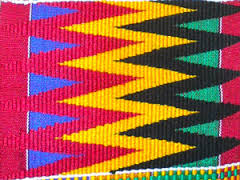Jan 25, 2016
Bonwire Kente Weaving Institute
The kente cloth is woven on a narrow horizontal loom. The loom usually uses four heddles (asanan), but in special cases, six or seven heddles (asasia) may be used. The cloth is woven in narrow strip (called ntomaban or bankuo) that is about 3-5 inches wide and about 5-6 feet long. Several strips are sewn together to make a wider piece of cloth for both men and women. A man's cloth may contain up to 24 strips and measure about 5x8 feet. The woman's two-piece cloth may contain 8-12 strips each piece. The largest known kente cloth, measuring about 12X20 feet, is the piece Ghana presented to the United Nations in 1960. This cloth is called tikoro nko agyina - one head does constitute a council.
The Asante weaver refers to kente as nwentoma (woven cloth) to distinguish it from the factory-made cloth (ntoma) and the adinkra cloth that is stamped (ntiamu ntoma) by the block-print technique. The nwentoma is of various categories: ahwepan (plain weave); topreko (plain weave with simple weft inlays); and faprenu (double weave technique that hides the warp threads).
The warp threads are laid in such fashion to give a name and meaning to the cloth. At the same time, the weft designs or motifs are each given a name and meaning. These names and meanings reflect Akan beliefs, historical events, social and political organization in the Akan society, or may be named after all manner of people.
The ntomaban (strip) called epie akyi (leopard's back), is made up of weft motifs called nwotoa (snail shell), fa hia kotwere Agyeman (lean your poverty on Agyeman), akyem (shield), babadua, and nkyinkyim (zigzag). The epie akyi imitates the beautiful patchwork of stripes on the leopard. And, one expression associated with epie akyi is: kurotwamansa to nsuo mu a, ne ho na efo; ne ho nsensanee no de ewo ho daa - the leopard only gets wet when it falls into water; the water does not wash off its stripes. Epie akyi is also used in military terms to refer to the defensive position of using stockpiles of plantain stalks to stop the cannons of the Europeans.
SOME ASPECTS OF THE KENTE WEAVING PROCESS
Locally grown cotton is spun into yarn usually by women. Seeds are squeezed out of the harvested cotton bolls; the fibers are bowed by plucking a small string bow to loosen them, then spun using a weighted spindle. Hand spinning is a fast-dying craft in Ghana. The yarn is then scrubbed with starch and then allowed to dry before it is wound onto bobbins. The yarn may be dyed in many colors. Besides cotton, silk, lurex, and rayon are used as yarn for weaving kente.
CEFIKS is working with the Bonwire Kente Weaving Institute to train new weavers and help carry out new innovations.
Click here to visit gallery

